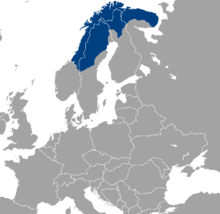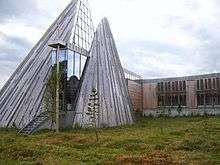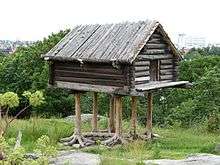Sami culture
The Sami are an indigenous ethnic group, endemic to the northern parts of Norway, Sweden, Finland and the Kola Peninsula in Russia.
| Nordic countries: Denmark, Finland, Iceland, Norway, Sweden Vikings and the Old Norse • History • Sami culture • Winter • Right to access • Boating • Hiking • Cuisine • Music • Nordic Noir |
Regions

- Norway: Troms and Finnmark
- Sweden: Norrbotten County, Västerbotten County and Jämtland County
- Finland: Finnish Lapland;
Enontekiö, Inari, Utsjoki and part of Sodankylä are recognised as the Sami native region - Russia: Kola Peninsula
Cities

- Inari (Anár, Aanaar, Aanar) – the "capital" of Finnish Samis
- Jokkmokk, Sweden, a Sami town with an annual fair in February
- Karasjok (Kárášjohka), Finnmark, Norway – a village where the Sami Parliament of Norway is located
- Kautokeino (Guovdageaidnu) – a centre of Sámi culture, with a 90% Sámi population
- Kiruna (Giron) – the seat of the Swedish Sami Parliament
- Östersund (Staare) – town with the Sami information centre of the Swedish Sami parliament
Other destinations
Sámi culture is not about city life. Although you will meet authentic Sámi in the towns, find museums, shops and exhibitions there and may have the chance to participate in Sámi festivals, an understanding of the Sámi necessarily includes a feeling for the vast areas outside cities. If you have time and are lucky you may join Sámi working with the reindeer on the fells. If you are a hiker you will appreciate the large wilderness areas. Otherwise you may get on an arranged tour, perhaps fishing in a lake far from the busy modern life.
Understand


_(cropped).jpg)
Reindeer husbandry is an important livelihood among the Sámi and the culture surrounding the trade is important also for many with other professions. Even traditionally, though, not all Sámi have been involved in big scale reindeer husbandry, but lived from fishing, hunting and similar, having reindeer mostly as draft animals. Today many Sámi work in modern trades. Tourism is an important income in Sápmi, the Sámi area.
As reindeer herders or hunters the Sámi traditionally followed the animals on their seasonal migrations, having a winter village, calving and autumn grounds and summer grounds, and mobile homes (goahtis and lávvus). As the movements between pastures took quite some time, they had eight seasons, not four. Also those living mainly from fishing moved as seasons changed. The reindeer still have seasonal pastures (mostly treeless areas in summer, either in hight terrain or by the coast), but the borders between countries, closed after failed negotiations in the 19th century, restricted the migration. With the introduction of motorized terrain vehicles (most importantly the snowmobile), reindeer herders have been able to reach their livestock from a permanent home, but some of the people you will meet were born before this revolution, and some choose to still live in or near the traditional summer settlements in summer, close to the livestock.
Many tourists in Sápmi want to experience the exotic Sámi culture. This has lead to non-Sámi dressing in quasi-Sámi clothes and performing "Sámi" rituals (thought of as insults by many Sámi). You may enjoy these shows for what they are, but if you want to learn about Sámi culture, you should be wary of the difference. On the other hand real Sámi are, despite preserving a distinct culture and identity, to varying degrees integrated in the modern lifestyle, and marriages across the cultural borders are quite common – you should not try too hard to find "authentic" Sámi.
Joik is a traditional Sami singing style, which is re-interpreted today as a genre of popular music; see Nordic music.
Talk
There are several Sámi languages, although Northern Sámi is clearly the most widely spoken and understood also by many Sámi not having it as mother tongue. Because of earlier language policy not all Sámi speak Sámi at all. All speak the majority language of the country and they study English in school like other citizens of their respective countries. In Finland, Swedish is non-compulsory for those getting their education in Sámi.
Most places in Sápmi have Sámi names. The names in the non-Sámi languages are often based on these, although the spelling may be quite different.
Get in
There are quite a few airports in the Sápmi area, with at least domestic flights. Kittilä in Finland has relatively many seasonal flights from European destinations.
The railways in Finland terminate at Kolari and Kemijärvi, with Rovaniemi the most important hub for continuing by coach.
Trains in Sweden go to Kiruna, and to Narvik in Norway. Inlandsbanan is usable too.
The Norwegian trains terminate at Bodø.
Russian trains go to Murmansk, and with sparse services somewhat beyond.
For Norway, the Hurtigruten ferry service is an option.
Get around
The area is served by coaches, mostly at least with daily services. If you use your own car, be wary of the Norwegian terrain (there is quite a difference between the shortest route and the route by car) and driving conditions in winter. The distances are long, so biking requires some dedication. Taxis are a viable option for some destinations.
See
-Riksantikvarie%C3%A4mbetet.jpg)
Museums
- 🌍 Siida (Inari Sámi Museum), Inarintie 46, Inari, FI-99870, ☎ +358 400-898-212, e-mail: siida@samimuseum.fi. Jun 1-Sep 19: 09:00–20:00; Sep 20–Mar 31: 10:00–17:00. The National Museum of the Finnish Sámi in Inari. Adults: €10.
- 🌍 Nutti Sámi Siida – Reindeer park and Sámi camp, Marknadsvägen 84, 981 91 Jukkasjärvi, ☎ +46 980 21329, e-mail: info@nutti.se. Winter season: Dec 1–Apr 14, Daily 10:00–17:00; Summer season: June 17–Aug 11 Daily 10:00–16:00. Visitor center in Jukkasjärvi, Sweden, with reindeer and information about the Sámi people. Café and handicraft shop. Winter: Adult 150 SEK, student 100 SEK, children 75 SEK. Summer: Adult 120 SEK, student 100 SEK, children 60 SEK.
- Ájtte (Jokkmokk). Museum on the fells and Sami culture.
- Saemien Sijte (Snåsa, Nord-Trøndelag). Culture centre and museum on Southern Sámi culture.
Most national park visitor centres in Sápmi tell also about the Sámi.
Theatres
- Beaivváš Sámi Našunálateáhter in Kautokeino
- Giron Sámi Teáhter in Kiruna
Do
- St Mary's Day Celebrations (Hetta). Late March. Dance, music, lassoing competitions, reindeer races. Handicrafts for sale.
- Easter festival (Kautokeino). Easter, programme all week. Festival with exhibitions, races, ice fishing, film and music festivals, concerts. The Easter has been an important time, the last chance to gather with friends before it is time to move the reindeer to the calving grounds.
Eat

- See also: Nordic cuisine
As agriculture is quite a hopeless enterprise with most crops at these latitudes, most dishes are based on reindeer, fish and game. Also some wild plants play or have traditionally played an important role, such as berries, especially cloudberry and crowberry, and Norwegian angelica (Sámi: Olbmoborranrássi, Norwegian: kvann).
Drink
Sleep
As the Sámi moved between summer and winter lands they had mobile homes. The lávvu is made from straight tree stems (resembling a teepee) and thus easy to build from scratch in fell birch forest (if you have the fabric or hides to cover the structure), while goahtis are more elaborate, with larger floor area. The lávvu stems are often left behind for next use, while the goahti trees are carried along. There are also goahtis made from timber or peat. These mobile and stationary homes are still commonly used, both as tourist attractions and as traditional accommodation, although not as primary home any more.
Many tourist businesses invite you to drink coffee by the fire in a lávvu. Nearly always you will get more familiar lodging for the night, in a few cases with something built to resemble a lávvu, but with normal beds and mattresses.
Stay safe
Sápmi, the Sámi region, is mostly very sparsely populated, with a harsh or even extreme climate. Do not venture into the wilderness without proper skill and equipment.
Respect
Sami are often known in other languages as Lap, Lapons, Laplanders or similar, but many of them regard these as pejorative terms. Use the word Sami for the ethnicity and the language, and Sápmi for their collective territory.
The Sami community has some unresolved disputes internally, as well as with the national governments, and the majority population. Land management rights (including mining, reindeer herding, fishing and wildlife management) is a particularly sensitive topic.
Go next
See also
- Vikings and the Old Norse for early Scandinavian history
- Minority cultures of Russia